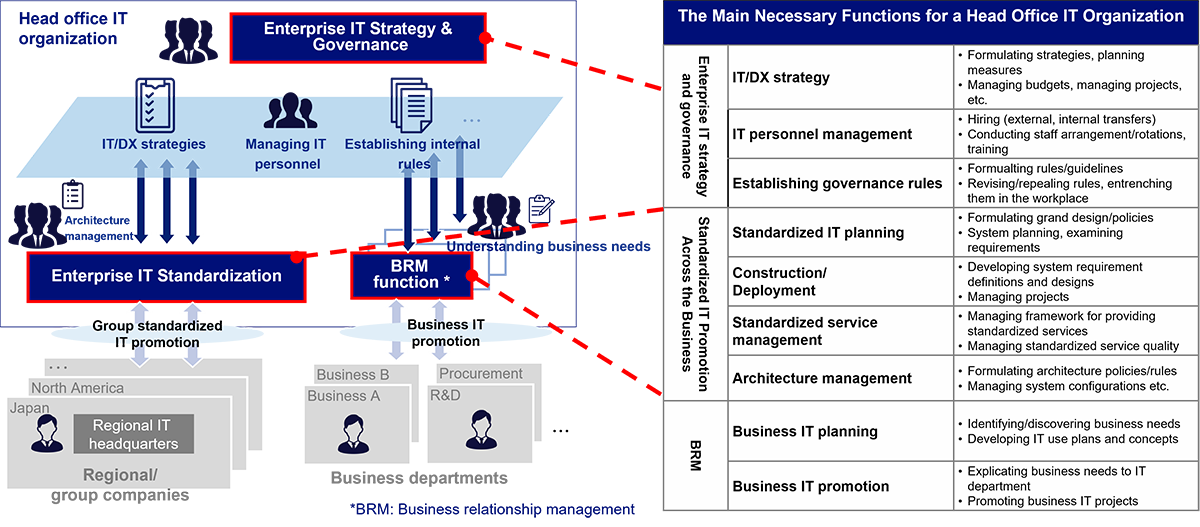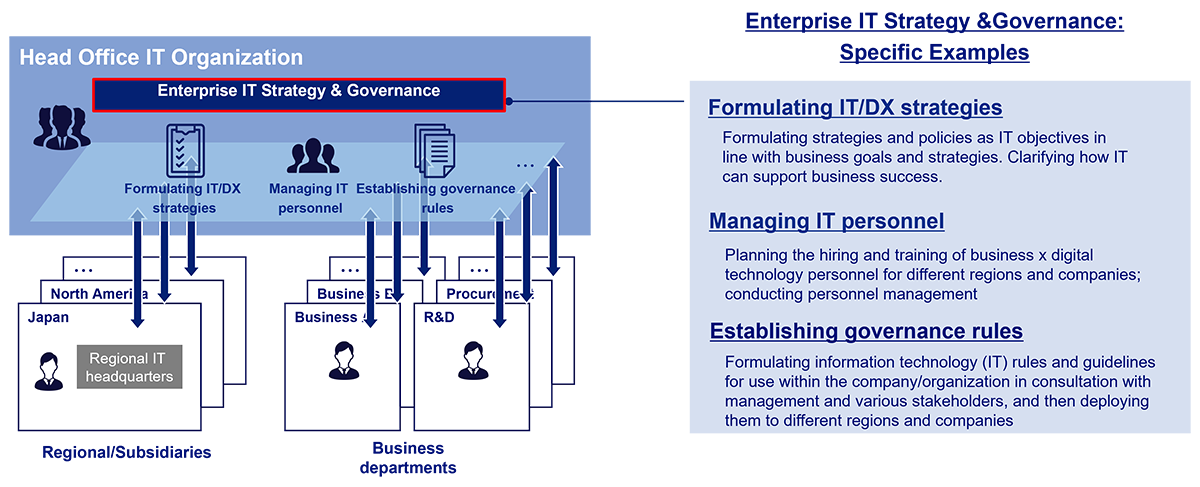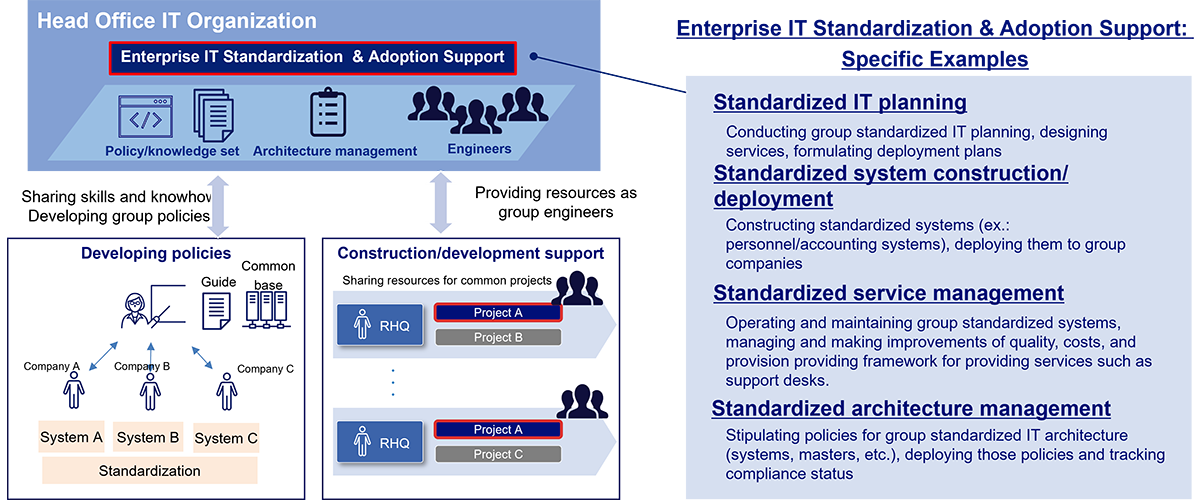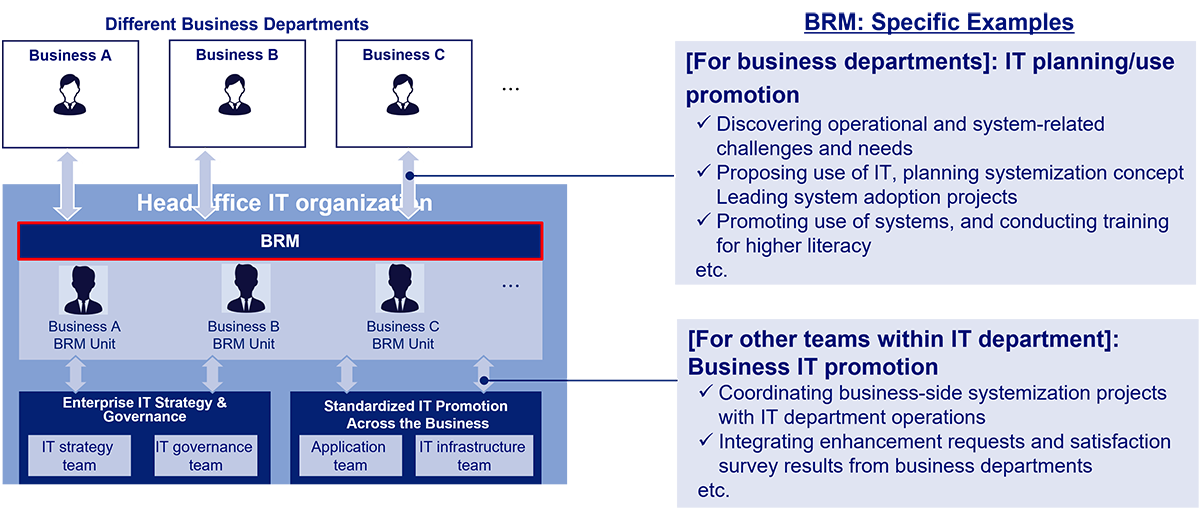Why Enterprise IT Management Matters More Than Ever
As Japanese companies face shrinking domestic markets, many are expanding globally to stay competitive—especially in manufacturing. But this expansion has brought new challenges. With more subsidiaries, regions, and business units in play, managing IT across the enterprise has become more complex than ever.
Cybersecurity risks are evolving. Regulatory requirements differ by country. IT assets are often underutilized. And strategies can easily drift apart without clear alignment.
In this blog, we explore three core functions head office IT organizations must have to take the lead in managing enterprise-wide IT effectively—backed by real-world case studies.
The 3 Big Challenges in Enterprise IT Management
To succeed, companies must strike a balance between:
- Enterprise-wide optimization (driving efficiency and governance across the whole organization)
- Business unit optimization (meeting the unique needs of individual operations)
Based on consulting experience, NRI has identified the following 3 challenges:
1. Fragmented CommunicationHead offices and business units often don’t share enough information about IT issues or digital strategies. This leads to uncoordinated investments and inconsistent planning.
2. Lack of StandardsWithout clear rules or systems for standardization, similar IT systems proliferate across the organization. This makes data integration difficult, keeps costs high, and scatters IT expertise.
3. Inflexible SupportHead office IT teams can be slow to respond to the needs of subsidiaries, forcing local teams to address issues independently. This delays digital initiatives and hurts productivity.
3 Functions Every Head Office IT Organization Should Have
To overcome these challenges, head office IT must be equipped with three essential functions:
- Enterprise IT Strategy & Governance
- Enterprise IT Standardization & Adoption Support
- Business Relationship Management (BRM)
Each of these functions plays a key role in creating a more unified, efficient, and responsive IT environment.
Figure 1: 3 Functions Every Head Office IT Organization Should Have

1. Enterprise IT Strategy & Governance: Aligning Technology with Business Goals
This function ensures that the IT strategy is aligned with corporate goals. It oversees medium-term planning, budgeting, resource allocation, and governance.
Key Roles:
- Develop enterprise IT strategies aligned with business priorities
- Propose and track IT investment plans and budgets
- Monitor major IT projects and allocate resources accordingly
- Plan for the recruitment and training of IT talent
- Establish and enforce governance policies across business units
A North American manufacturer structured its IT department into a 'Enterprise IT' team focused on back-office standardization and a 'Business IT' team supporting business unit needs. A governance control team under the Global CIO harmonizes both, balancing efficiency and agility. This structure supports what NRI calls 'ambidextrous IT management.'
Figure 2: Enterprise IT Strategy & Governance

2. Enterprise IT Standardization and Adoption Support: Streamlining Systems
This function focuses on optimizing applications and infrastructure through standardization, reducing costs, and improving service quality.
Key Roles:
- Plan standardized applications and infrastructure
- Manage development, implementation, and vendor relationships
- Provide centralized support and quality control
- Promote adoption of standardized systems and track deployment
Case Study: Company B
A Canadian pharmaceutical firm developed enterprise-wide IT architecture and centralized IT services. It also established an offshore engineering and operations hub in India, including a Center of Excellence for SAP. This structure improved cost efficiency and enabled consistent process reform across the business.
Figure 3: Enterprise IT Standardization & Adoption Support

3. Business Relationship Management: Connecting IT and Business
The BRM function ensures IT is used effectively by business units, bridging communication and strategy gaps between technology and operations.
Key Roles:
For Business Units:
- Identify business challenges that IT can address
- Lead IT planning and adoption initiatives
- Promote system use and provide user training
- Align initiatives with enterprise IT strategy
- Coordinate system planning with standardized architecture
- Collect feedback to improve satisfaction and outcomes
Case Study: Company C
A North American manufacturer set up BRM teams aligned to functions like R&D, sales, and procurement. It regionalized its BRM teams for more localized support and moved from external consultants to in-house talent trained near top universities. This shift strengthened trust and collaboration between IT and business units.
Figure 4: Business Relationship Management

Final Thoughts: Strengthen Your Enterprise IT Management
Effective enterprise IT management is critical for organizations operating globally. By building out these three functions—Strategy & Governance, Enterprise IT Standardization & Adoption Support, and BRM—you can improve agility, efficiency, and alignment across all business units.
Every organization’s needs differ. How you implement these functions should reflect your IT maturity, available resources, and strategic goals. NRI has extensive experience guiding companies through these transformations—from assessment and planning to execution and support.
We’re here to help you unlock the full potential of your enterprise IT.
Profile
-
Shingo SatakePortraits of Shingo Satake
IT Management Consulting Department
Joined NRI in 2008. Specializes in DX strategy, public sector reform, and global IT management.
-
Shotaro SakuraiPortraits of Shotaro Sakurai
NRI Thailand
Joined NRI in 2022 after working in digital transformation and system design. Focuses on global IT strategy and organizational reform.
-
Mari KinookaPortraits of Mari Kinooka
IT Management Consulting Department
At NRI since 2018, she focuses on global IT management strategy and digital talent development.
* Organization names and job titles may differ from the current version.